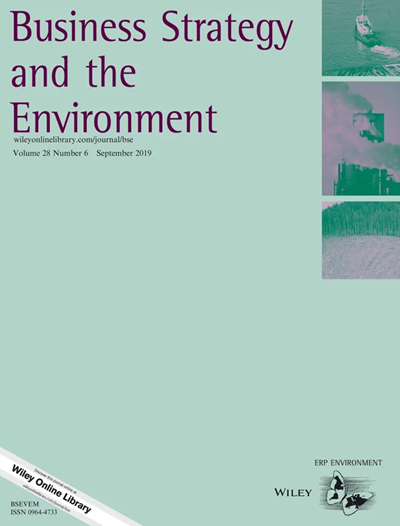Integrating Life Cycle Assessment, Monetised Externalities and Value Alignment for Strategic Reconfiguration of Circular Business Models: The Case of Smartphones
IF 13.3
1区 管理学
Q1 BUSINESS
引用次数: 0
Abstract
The smartphone industry faces sustainability challenges from greenhouse gas emissions and resource depletion to growing e‐waste volumes. Circular business models have been proposed as a pathway to address these issues, yet their adoption remains limited, lacking integrative assessment frameworks that connect environmental performance with business viability. This study develops and applies such a framework combining life cycle assessment, monetisation of externalities via the eco‐cost method and a structured value alignment score. Using primary data from Fairphone 5 as a case study, four scenarios with increasing levels of circularity are analysed: (S0) a linear business‐as‐usual baseline, (S1) extended use with moderate user‐led repairs, (S2) long‐life use with intensified user‐led repairs and (S3) a product‐as‐a‐service model based on manufacturer‐led refurbishment. The results demonstrate that all circular business models outperform the linear baseline in terms of both environmental impacts and monetised externalities. Incremental models that extend product lifespans through user‐led repair (S1, S2) yield significant reductions in greenhouse gas emissions (up to −46%) and eco‐costs (−36%). However, their strategic alignment is constrained by weakened consumer value propositions and original equipment manufacturing profitability. In contrast, a product‐as‐a‐service model (S3) achieves superior outcomes by internalising life cycle responsibility and aligning incentives with longevity and service quality, reflecting systemic reconfiguration of value logics. The study contributes theoretically by operationalising an integrated framework that bridges environmental metrics with strategic value dimensions to evaluate circular business models. Practically, it provides firms a structured tool for evaluating trade‐offs and advancing scalable pathways towards a sustainable circular economy.循环商业模式战略重构的整合生命周期评估、货币化外部性和价值一致性:以智能手机为例
智能手机行业面临着从温室气体排放、资源枯竭到不断增长的电子垃圾量的可持续性挑战。循环商业模式已被提议作为解决这些问题的途径,但其采用仍然有限,缺乏将环境绩效与商业可行性联系起来的综合评估框架。本研究开发并应用了这样一个框架,该框架结合了生命周期评估、通过生态成本方法实现外部性货币化和结构化价值一致性评分。使用Fairphone 5的原始数据作为案例研究,分析了四种循环度不断提高的情景:(S1)线性业务照常基线,(S1)用户主导的适度维修的延长使用,(S2)用户主导的强化维修的长期使用和(S3)基于制造商主导的翻新的产品即服务模型。结果表明,在环境影响和货币化外部性方面,所有循环商业模式都优于线性基线。通过用户主导的维修(S1, S2)延长产品寿命的增量模型可显著减少温室气体排放(高达- 46%)和生态成本(- 36%)。然而,他们的战略结盟受到削弱的消费者价值主张和原始设备制造盈利能力的限制。相比之下,产品即服务模式(S3)通过内部化生命周期责任,并将激励与寿命和服务质量相结合,反映了价值逻辑的系统性重构,从而取得了更好的结果。该研究通过将环境指标与战略价值维度连接起来的综合框架用于评估循环商业模式,在理论上做出了贡献。实际上,它为企业提供了一个结构化的工具来评估权衡和推进可持续循环经济的可扩展路径。
本文章由计算机程序翻译,如有差异,请以英文原文为准。
求助全文
约1分钟内获得全文
求助全文
来源期刊

Business Strategy and The Environment
Multiple-
CiteScore
22.50
自引率
19.40%
发文量
336
期刊介绍:
Business Strategy and the Environment (BSE) is a leading academic journal focused on business strategies for improving the natural environment. It publishes peer-reviewed research on various topics such as systems and standards, environmental performance, disclosure, eco-innovation, corporate environmental management tools, organizations and management, supply chains, circular economy, governance, green finance, industry sectors, and responses to climate change and other contemporary environmental issues. The journal aims to provide original contributions that enhance the understanding of sustainability in business. Its target audience includes academics, practitioners, business managers, and consultants. However, BSE does not accept papers on corporate social responsibility (CSR), as this topic is covered by its sibling journal Corporate Social Responsibility and Environmental Management. The journal is indexed in several databases and collections such as ABI/INFORM Collection, Agricultural & Environmental Science Database, BIOBASE, Emerald Management Reviews, GeoArchive, Environment Index, GEOBASE, INSPEC, Technology Collection, and Web of Science.
 求助内容:
求助内容: 应助结果提醒方式:
应助结果提醒方式:


